
The National Gallery of Victoria, popularly known as the NGV, is an art museum in Melbourne, Victoria, Australia. Founded in 1861, it is Australia's oldest and most visited art museum.

The National Gallery of Australia (NGA), formerly the Australian National Gallery, is the national art museum of Australia as well as one of the largest art museums in Australia, holding more than 166,000 works of art. Located in Canberra in the Australian Capital Territory, it was established in 1967 by the Australian Government as a national public art museum. As of 2022 it is under the directorship of Nick Mitzevich.
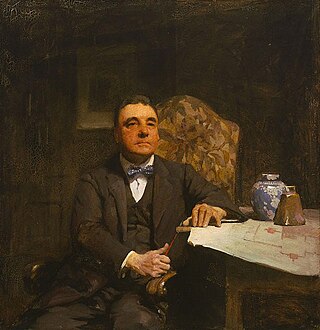
The Archibald Prize is an Australian portraiture art prize for painting, generally seen as the most prestigious portrait prize in Australia. It was first awarded in 1921 after the receipt of a bequest from J. F. Archibald, the editor of The Bulletin who died in 1919. It is administered by the trustees of the Art Gallery of New South Wales and awarded for "the best portrait, preferentially of some man or woman distinguished in Art, Letters, Science or Politics, painted by an artist resident in Australia during the twelve months preceding the date fixed by the trustees for sending in the pictures". The Archibald Prize has been awarded annually since 1921 and since July 2015 the prize has been AU$100,000.

Brett Whiteley AO was an Australian artist. He is represented in the collections of all the large Australian galleries, and was twice winner of the Archibald, Wynne and Sulman prizes. He held many exhibitions, and lived and painted in Australia as well as Italy, England, Fiji and the United States.

Arthur Merric Bloomfield Boyd was a leading Australian painter of the middle to late 20th century. Boyd's work ranges from impressionist renderings of Australian landscape to starkly expressionist figuration, and many canvases feature both. Several famous works set Biblical stories against the Australian landscape, such as The Expulsion (1947–48), now at the Art Gallery of New South Wales. Having a strong social conscience, Boyd's work deals with humanitarian issues and universal themes of love, loss and shame.

Sir Arthur Ernest Streeton was an Australian landscape painter and a leading member of the Heidelberg School, also known as Australian Impressionism.
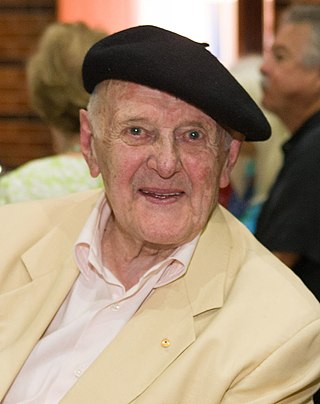
John Henry Olsen AO OBE was an Australian artist and winner of the 2005 Archibald Prize. Olsen's primary subject of work was landscape.
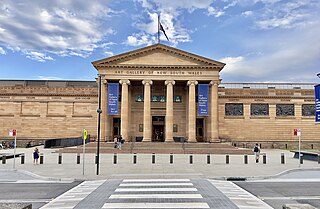
The Art Gallery of New South Wales (AGNSW), founded as the New South Wales Academy of Art in 1872 and known as the National Art Gallery of New South Wales between 1883 and 1958, is located in The Domain, Sydney, Australia. It is the most important public gallery in Sydney and one of the largest in Australia.

Frederick Ronald Williams was an Australian painter and printmaker. He was one of Australia’s most important artists, and one of the twentieth century's major landscapists. He had more than seventy solo exhibitions during his career in Australian galleries, as well as the exhibition Fred Williams - Landscapes of a Continent at the Museum of Modern Art in New York in 1977.
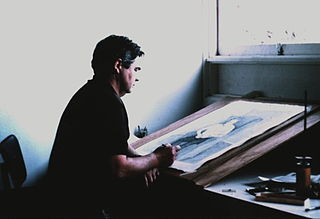
John Brack was an Australian painter, and a member of the Antipodeans group. According to one critic, Brack's early works captured the idiosyncrasies of their time "more powerfully and succinctly than any Australian artist before or since. Brack forged the iconography of a decade on canvas as sharply as Barry Humphries did on stage."

Collins St., 5 pm is a 1955 painting by Australian artist John Brack. The painting depicts office workers walking along busy Collins Street in Melbourne after finishing work for the day—"Blank-faced office workers hurry by like sleep-walkers, thinking only of the pubs or their homes in the suburbs". Brack conceived the work after reading T. S. Eliot's 1922 poem The Waste Land. It is considered a companion piece to Brack's earlier work The Bar.

On the wallaby track is a 1896 painting by the Australian artist Frederick McCubbin. The painting depicts an itinerant family; a woman with her child on her lap and a man boiling a billy for tea. The painting's name comes from the colloquial Australian term "On the wallaby track" used to describe itinerant rural workers or "swagmen" moving from place to place for work. The work has been described as "among the best known and most popularly admired of Australian paintings".
Robert Rooney (1937–2017) was an artist and art critic from Melbourne, Australia, and a leading figure in Australian Conceptual art.
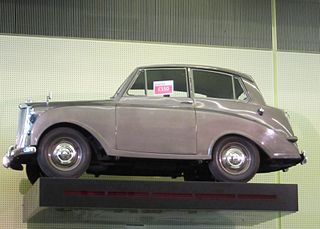
The Car is a 1955 painting by Australian artist John Brack. The painting depicts a family in a car on a drive in a rural area. The painting shows the father looking at the road ahead while the mother and children look towards the viewer. While the whole car cannot be seen, the car itself is identifiable as a Triumph Mayflower. The landscape, seen through the windows of the car, has been said to be inspired by the work of his contemporary Fred Williams.
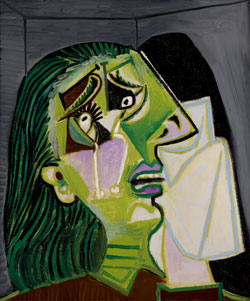
The theft of The Weeping Woman from the National Gallery of Victoria took place on 2 August 1986 in Melbourne, Victoria, Australia. The stolen work was one of a series of paintings by Pablo Picasso all known as The Weeping Woman and had been purchased by the gallery for A$1.6 million in 1985—at the time the highest price paid by an Australian art gallery for an artwork. A group calling itself "Australian Cultural Terrorists" claimed responsibility, making a number of demands in letters to the then-Victorian Minister for the Arts, Race Mathews. The demands included increases to funding for the arts; threats were made that the painting would be destroyed. After an anonymous tip-off to police, the painting was found undamaged in a locker at Spencer Street railway station on 19 August 1986. The theft still remains unsolved.
Peter Bray Gallery was established as Stanley Coe Gallery in 1949 before being renamed in 1951, after a change of management. Situated at 435 Bourke Street, Melbourne, Victoria, Australia, it closed in 1957. Many of the major names in mid-century Australian contemporary art showed there during its brief, but very busy, lifespan.
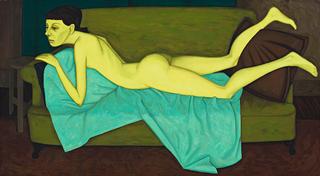
The Boucher Nude is a 1957 painting by Australian artist John Brack. The painting is a nude, depicting a woman lying on a sofa. Sasha Grishin, the William Dobell Professor of Art History at the Australian National University claimed that "The Boucher Nude can be justly regarded as one of the great masterpieces in Australian art."
Sydney Ball was an Australian abstract painter. He has been called ‘one of Australia’s leading colour abstract painters. He has also been credited with bringing large scale abstract expressionist paintings, or Color Field paintings, to Australia.

The Breakfast Table is a 1958 still life painting by Australian artist John Brack. The painting depicts a table after breakfast but before the plates, cups and cutlery have been cleared.
Breakfast has finished and the participants have gone, although the detective-like artist has set out visual clues that tell us about the people who were here. To begin with Brack himself, his painter-wife, and their four daughters are signified by a glass, a tea cup and four mugs. Of course, all these vessels are empty, much like the egg shell in its cup, and the five plates dotted with a few crumbs left from toast. Even bottles are drained of liquids. Not a scrap of food remains. No crusts, no dabs of butter, no unconsumed dregs of milk.
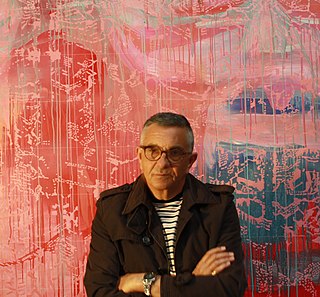
Jon Cattapan is an Australian visual artist best known for his abstract oil paintings of cityscapes, his service as the 63rd Australian war artist and his work as a professor of visual art at the University of Melbourne in the Faculty of Fine Arts and Music at the Victorian College of the Arts. Cattapan's artworks are held in several major galleries and collections, including the National Gallery of Victoria, the Art Gallery of New South Wales, Queensland Art Gallery, and the National Gallery of Australia.


















